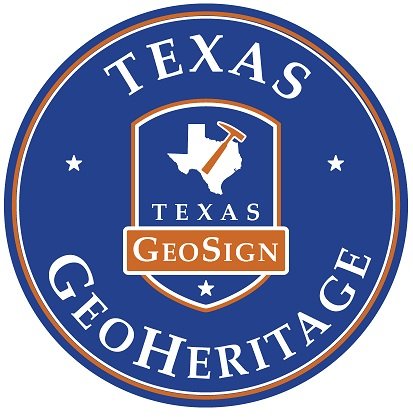Geoheritage in Texas
Geoheritage sites are areas of geologic features with significant scientific, educational, cultural, and/or aesthetic value. These sites have the potential to advance the public understanding of science, support scientific studies, serve as outdoor classrooms, provide recreational use, and may also provide economic support to local communities. In this presentation, we will provide an overview of Bureau of Economic Geology’s Geoheritage/GeoSign program. We will also invite feedback and ideas for the identification of geoheritage sites in Texas.
Linda Ruiz McCall is a geologist, educator, and business woman with experience in government service, private industry, and public education. A past AGS President, Linda holds a Bachelor of Science in Geological Sciences and a Master’s in Business Administration from The University of Texas at Austin, and a Master of Arts in Secondary Science Education from Teachers College of Columbia University. Linda currently serves as a Program Manager for the Bureau of Economic Geology. Her experience includes project management and communication with an emphasis on geology, water, and energy resources. Linda currently leads the Bureau’s outreach efforts including the Geoheritage/GeoSign project.
Charles “Chock” Woodruff, Jr. holds B.A. and M.S. degrees in geology from Vanderbilt University and a Ph.D. in geology from the University of Texas at Austin. Chock is a past AGS President, Honorary member, and recipient of the AGS Distinguished Service Award. He has been employed as a professional geologist in Austin for almost 50 years and is currently working for the Bureau of Economic Geology and is a Senior Lecturer in the Department of Civil, Architectural, and Environmental Engineering at U.T. He also is self-employed as a consulting geologist in Austin. Chock is a major contributor to the Geoheritage/GeoSign project.
Cole Carrabba: I am an undergraduate hydrogeology student at UT Austin where I will be graduating this coming May. My primary research at UT is focused on estimating the amount of tire wear pollution on the roads of central Austin, but I am truly fascinated with Texas ecology and enjoy learning about it in my free time. I am interested in working in water resource management, contaminant remediation, and coastal resilience.
Quantifying tire wear particles on Austin, Texas roads: early insights towards an overlooked source of pollution
Tires are a commonly underrepresented source of microplastic pollution. Tire tread wears throughout the lifespan of the tire, and a large portion of this material is initially deposited on the road. Large gaps in knowledge begin to exist directly after particle emission, but recent studies have shown microscopic rubber particulates in high concentrations on roadways[1]. Although the quantity of microplastics entering the environment at the road interface remains ambiguous, efforts have been made to estimate emissions in some regions of the globe[2]. In this study the quantities of tire microplastic on Austin, Texas roads were measured at several locations with a vacuum filtration system. The samples were separated by density and their plastic particles counted with a Leica M125C microscope. This dataset is the first attempt at measuring in-situ tire-wear pollution in the state of Texas. Initial counts of each sample contained an average of 1496 tire rubber particles between 70-150 μm in a 0.093 m2 area (1 ft2) of road shoulder along several Austin roads. An accurate estimation of tire wear emissions will serve as helpful preliminary information for future, upscaled research efforts. Understanding the transport pathways of microscopic pollutants will be fundamental to any form of mitigation attempt down the road.
Michael Snook is a fourth-year general geology major graduating at the end of this semester. After graduation, he plans to complete an internship with the USGS in the Cooperative Summer Field Training program before considering future graduate school plans. Although Michael’s research and academic focus has been on hydrology, he is interested in turning towards his true passion for structural geology in graduate school and beyond.
Differences in the hydration state of trees in the riparian zone of urban and rural streams in the context of urbanization and the urban heat island
The hydration state of trees can be characterized by leaf water potential (LWP), and consideration of how LWP changes on diurnal and seasonal timescales can reveal a tree’s water use strategies. Plants adjust their strategies based on meteorological inputs such as vapor pressure deficit, wind speed, insolation and latent heat partitioning, and precipitation, among others. Besides meteorological variables, antecedent conditions of the subsurface, namely soil water content and water table depth, are factors to which trees must also dynamically adjust their water use strategies to prevent hydraulic stress. This study investigates in general the differences between riparian tree hydration in urban and rural settings due to changes in local meteorology and subsurface moisture conditions brought on by urbanization, and in particular the difference in response between the two after a rainfall event. At the rural site, the most negative LWP values were seen in the mid-morning (8:00 am -11:00 am) before the rain, whereas after the rain the most negative LWP values were seen at solar noon. At the urban site, the most negative LWP values were seen at solar noon both before and after the rain event. Additionally, LWP values were found to be very strongly correlated with vapor pressure deficit, temperature, solar radiation, and relative humidity at the urban site, whereas no correlation was found to any of these values at the rural site.
Warren Wegener is a fourth-year General Geology major in the Jackson School of Geosciences. He plans on seeking a career in the mineral resources industry and will be pursuing a master’s degree focused in Economic Geology at The University of British Columbia after graduating this Spring. He is passionate about the substantial role geoscientists will hold in the coming years to find and extract the resources necessary for the looming energy transition and excited to apply this interest professionally.
Investigation into fluid transport of the Trans-Pecos alkaline intrusions: Calcite veins and their implications on the economic potential of igneous bodies of the Diablo Plateau





